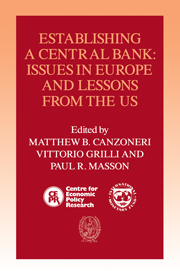Book contents
- Frontmatter
- Contents
- List of figures
- List of tables
- Preface
- List of conference participants
- 1 Introduction
- PART I THE DESIGN OF A CENTRAL BANK
- PART II TRANSITION FROM NATIONAL CENTRAL BANKS TO A EUROPEAN CENTRAL BANK
- 5 Hard-ERM, hard ECU and European Monetary Union
- 6 Voting on the adoption of a common currency
- PART III FISCAL POLICY REQUIREMENTS OF A COMMON CURRENCY AREA
- PART IV GLOBAL IMPLICATIONS OF A EUROPEAN CENTRAL BANK
- Index
5 - Hard-ERM, hard ECU and European Monetary Union
Published online by Cambridge University Press: 05 March 2012
- Frontmatter
- Contents
- List of figures
- List of tables
- Preface
- List of conference participants
- 1 Introduction
- PART I THE DESIGN OF A CENTRAL BANK
- PART II TRANSITION FROM NATIONAL CENTRAL BANKS TO A EUROPEAN CENTRAL BANK
- 5 Hard-ERM, hard ECU and European Monetary Union
- 6 Voting on the adoption of a common currency
- PART III FISCAL POLICY REQUIREMENTS OF A COMMON CURRENCY AREA
- PART IV GLOBAL IMPLICATIONS OF A EUROPEAN CENTRAL BANK
- Index
Summary
Introduction
The vision of Monetary Union in Europe is of long standing. The Werner Report of 1970 advocated the attainment of Monetary Union by 1980, but was buried beneath a soaring oil price and the collapse of Bretton Woods and the move to generalised floating in the early 1970s. The European Community, with some key exceptions, returned to an adjustable peg exchange rate system in 1979 with the launch of the Exchange Rate Mechanism (ERM for short). Helmut Schmidt and Valery Giscard d'Estaing embarked on the ERM against majority technical advice from economists at the time, but despite that the ERM must be judged an appreciable success: much more durable than its critics expected, and much more successful in establishing a credible and stable framework for anti-inflationary policy. Even the British have finally been won round.
In the early years of the ERM, parity realignments were frequent and sometimes large, on occasions requiring the temporary closure of foreign exchange markets while bargaining over the realignment went on. These frequent realignments were necessary because of the diversity of inflation rates between the participating countries. But the gradual convergence of inflation rates, itself a product of the ERM, led over time to smaller and less frequent realignments. This is illustrated in Figure 5.1, which shows realignments of the participating countries against the Deutsche Mark, which over this period did not devalue against any currency.
- Type
- Chapter
- Information
- Establishing a Central BankIssues in Europe and Lessons from the U.S., pp. 127 - 163Publisher: Cambridge University PressPrint publication year: 1992
- 1
- Cited by

